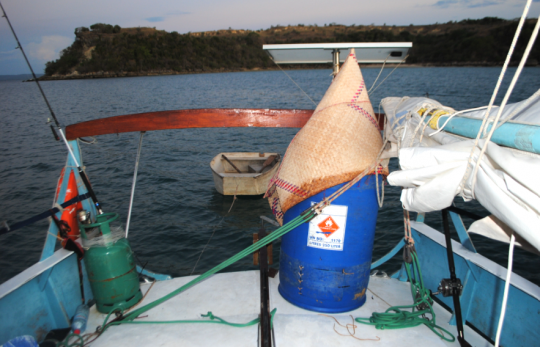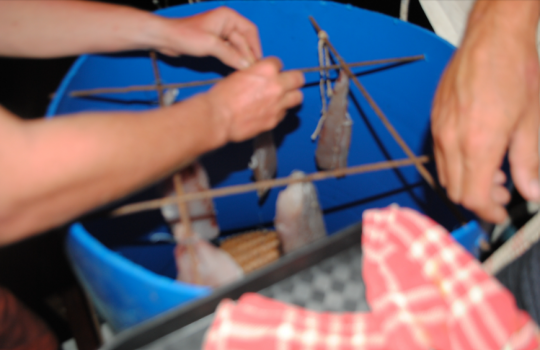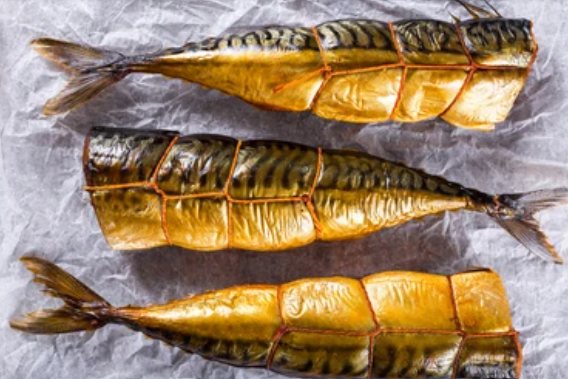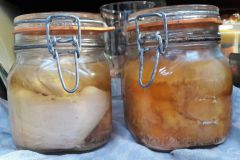Fishing for fresh fish undoubtedly remains a pleasure for most yachtsmen. But how do you manage excess catches? There's a practical solution: fish smoking. Placed at the stern of your sailboat or motorboat, and adapted to the space available, the smoker becomes your ally in preserving your catch. The process is well orchestrated: filleting, salting, rinsing, drying and, finally, smoking. Of course, the special moment remains the mise en bouche. Here's our advice and method for creating an artisanal smokehouse on board.
Smoker design
Hot smoking, a process that combines heat and smoke to cook food, requires well thought-out implementation and meticulous preparation of the components. The genesis of your smokehouse lies in the design phase, where every detail counts. To begin with, you need to find the right container. We'll take the example of a 250-liter recycled PVC barrel. However, note that this concept can be realized with a variety of materials, such as an old gas bottle for soldering enthusiasts, or even a wooden barrel.

The operating principle of the hot smoker comprises the following elements:
- A chip-fed combustion chamber
- A grid on which the fish pieces are suspended during the smoking process
- A ventilation system providing a current of air through which smoke is drawn through a chimney

In the lower part of the barrel, modulate a Garmix-type steel mesh, creating a U-shaped rail with a mesh of about 1 centimetre. Bend it to keep it at a distance of 3/4 cm from the bottom. To maintain the combustion process for the required time, this device should be filled with sawdust.
Be sure to drill a door of the appropriate size to allow chips to enter the smoke chamber. Opening and closing can be facilitated by using Dyneema stubs as hinges.
At the top of the barrel, you'll need to suspend the fish fillets on a wire mesh. To do this, obtain 4 concrete reinforcing bars, drill 8 openings of appropriate diameter, then arrange them to create a square configuration.
Finally, position a rolled-up mat at the top of the barrel to create a source of ventilation. In high humidity and hot weather, smoke will have difficulty rising and leaving the smoking chamber. Thanks to this system, you can adjust the diameter of the mat opening, thus increasing the delivery pressure. This configuration plays a crucial role in regulating temperature, air circulation and smoke distribution inside the chamber. Maintaining adequate delivery pressure is essential to ensure efficient circulation of smoke around the food to be smoked, guaranteeing even cooking and optimum flavor.

Brining
Fish must be properly prepared before smoking. Whether you opt for pieces, fillets or the whole fish, it must be gutted and rinsed before brining.
Mix water and salt in a container. The amount of salt depends on the type of fish and your personal preferences. In general, use around 60 to 80 grams of salt per liter of water.
Immerse the fish in a container large enough to hold it, then pour the cold brine over the fish so that it is completely submerged. The time required for brining varies according to the thickness of the fish. As a general rule, allow around 30 minutes to 1 hour for each centimetre of thickness. Avoid excessive brining, as this may make the fish too salty.
Once the recommended brining time has elapsed, remove the fish from the brine. Rinse thoroughly in cold water to remove excess salt.
Smoking
All that's left to do is hang each piece on the rebar rods using string or hooks. Make sure the distance between them is at least two centimetres.

Then fill the rail with a few handfuls of dry wood shavings. Do not use softwood. Then light them. It's important to note that the chips are only there to generate smoke and add flavor. For safety's sake, do not light the chips on windy days, to avoid any risk of fire on board. Likewise, smoking should be carried out when you are at anchor and not while sailing.
Once you've completed these steps, all you have to do is wait. On average, the smoking process takes between 6 and 8 hours. Use this time to relax, enjoy the marine environment and anticipate the delicious reward to come.
Conservation
The hot-smoking method for fish can be carried out quickly, in just a few hours. However, it is crucial to understand that smoking food in an accelerated way limits the incursion of smoke aromas. These tend to concentrate mainly on the outer surface of the food. As a result, the shelf life of products after hot smoking remains relatively short, ranging from a few days to several weeks. This is why, once the smoking phase is complete, we recommend placing the smoked pieces, cut up beforehand, in jars of olive oil with spices. This technique has a dual benefit: it prolongs the shelf life of the food, while attenuating the sometimes overly pronounced taste of the smoked fish.
You now have a clear idea that creating a smokehouse with your own hands is within everyone's reach. No specific knowledge is required, giving you the opportunity to spoil yourself and your loved ones with quality fish. Financially, the investment is minimal. All in all, an approach that combines simplicity with the satisfaction of enjoying home-cooked seafood!








